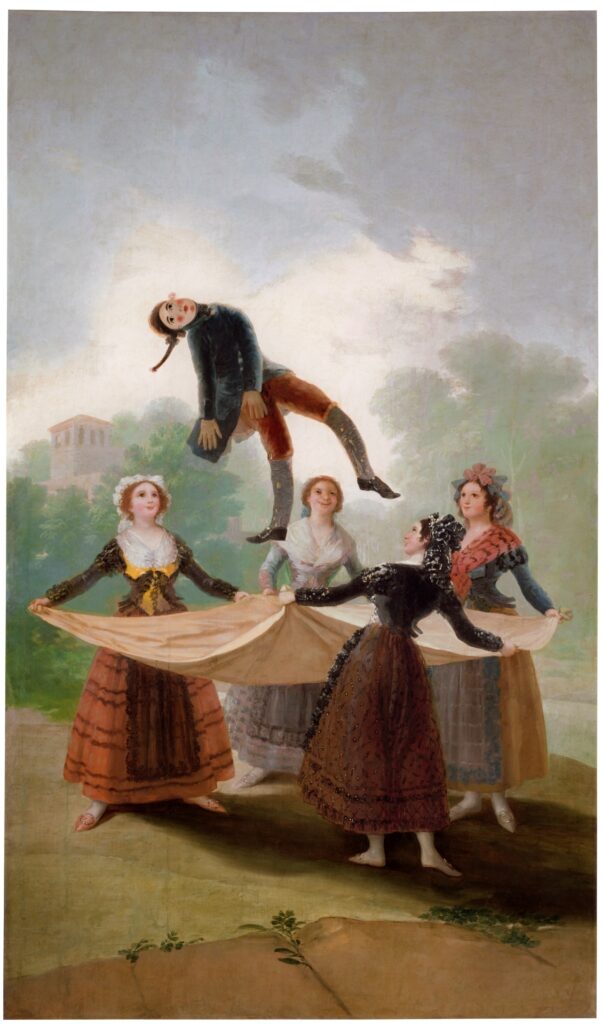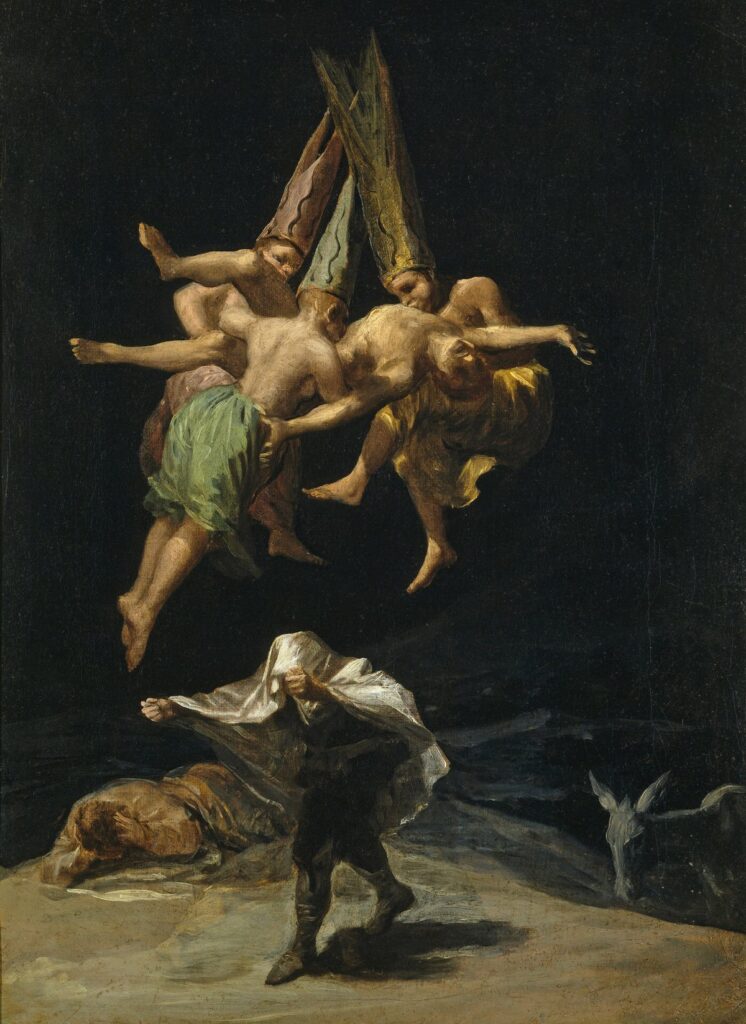Hey there, art aficionados! Get ready to be swept off your feet and enter into the electrifying world of Francisco Goya. With his jaw-dropping skills, boundless creativity, and a hint of theatrical flair, Goya has dazzled generations with his art. In this super fun article, we’ll dive into 14 of Goya’s paintings, and we’re throwing in a cool table with all the deets. So, let’s buckle up for this art-tastic adventure!
1. The Third of May 1808

| Date Completed | 1814 |
| Dimensions | 266 cm × 345 cm |
| Location | Museo del Prado, Madrid |
Our first stop is a wild ride back to the Peninsular War. “The Third of May 1808” is like an action-packed movie on canvas. It’s all about Spanish rebels saying, “Nope, you’re not taking us down!” The intense emotions and epic lighting in this painting will make you feel like you’re right there on the battlefield. This Goya’s masterpiece is kept in Madrid, the heart of Spain.
2. Saturn Devouring His Son

| Date Completed | 1819-1823 |
| Dimensions | 143 cm × 81 cm |
| Location | Museo del Prado, Madrid |
Next up, we’ve got a super creepy masterpiece of Goya’s collection, “Saturn Devouring His Son.” It’s all about Cronus (or Saturn) going a bit overboard on the whole fatherly protection thing by eating his own kids. The painter’s nightmares come to life in this painting. This masterpiece is not for the faint of heart!
3. The Nude Maja

| Date Completed | 1797-1800 |
| Dimensions | 97 cm × 190 cm |
| Location | Museo del Prado, Madrid |
Now, let’s dial down the spookiness with “The Nude Maja.” This one was scandalous in its day because it boldly showcases a lady in her birthday suit. Goya basically said, “Art isn’t just about fruit bowls and landscapes.” He pushed the envelope, and it paid off.
4. The Clothed Maja

| Date Completed | 1800-1805 |
| Dimensions | 98 cm × 191 cm |
| Location | Museo del Prado, Madrid |
Meet the twin of “The Nude Maja,” “The Clothed Maja.” Goya took the same seductive model and dressed her up. This one’s all about transformation, going from sultry to traditional in the blink of an eye.
5. The Black Paintings

| Date Completed | 1819-1823 |
| Dimensions | Varied |
| Location | Chilling in Museo del Prado, Madrid |
Time for the spook-fest! “The Black Paintings” is a collection of 14 murals painted right onto the walls of Goya’s house. We’re talking “Witches’ Sabbath” and “The Dog” here. Goya was diving headfirst into the abyss with these. They’re like windows into his haunted soul.
6. The Sleep of Reason Produces Monsters

| Date Completed | 1797-1798 |
| Dimensions | 21 cm × 15 cm |
| Location | Caprichos, Prado |
In “The Sleep of Reason Produces Monsters,” Goya goes all artsy-philosophical on us. It’s like an intellectual rollercoaster. The artist’s slumber leads to an unholy gathering of spooky creatures. It’s a reminder to stay sharp, or your dreams might turn into nightmares.
7. La Leocadia

| Date Completed | 1819 |
| Dimensions | 189 cm × 144 cm |
| Location | Museo de la Real Academia de Bellas Artes de San Fernando, Madrid |
Now, let’s catch our breath with “La Leocadia.” This one’s all about real-life stuff. Leocadia Weiss was a lady who took care of Goya in his later years. This painting captures the feels of their time together. It’s like a snapshot of a not-so-happy chapter in Goya’s life.
8. The Straw Manikin

| Date Completed | 1791-1792 |
| Dimensions | 150 cm × 266 cm |
| Location | Museo del Prado, Madrid |
Jump into the world of superstitions and folk beliefs with “The Straw Manikin.” Goya cooked up a seriously spooky figure made of straw and junk. It’s all about irrational fears and how the human mind can go to some weird places. Boo!
9. The Colossus

| Date Completed | 1810 |
| Dimensions | 116 cm × 105 cm |
| Location | Museo del Prado, Madrid |
“The Colossus” is a bit of a head-scratcher. This massive, shadowy figure stands tall amid chaos. It’s one of those paintings where Goya said, “I’m not telling you what it means. Figure it out for yourself!” And people are still doing just that.
10. Witches’ Flight

| Date Completed | 1797-1798 |
| Dimensions | 43 cm × 30.8 cm |
| Location | Caprichos, Prado |
“Witches’ Flight” is like a wild ride into the world of the supernatural. Goya’s etching shows witches taking off on their broomsticks. It’s part of his “Los Caprichos” series, and it’s a spellbinding mix of fantasy and reality.
11. The Madhouse

| Date Completed | 1812-1819 |
| Dimensions | 43 cm × 30.8 cm |
| Location | Varied (Housed in Museo del Prado, Madrid) |
Goya’s “The Madhouse” is like a sobering dose of reality. He puts the spotlight on mental illness and what life was like for those institutionalized back in the 19th century. It’s a deep dive into the human condition, and it’s pretty intense.
12. The Forge

| Date Completed | 1817-1819 |
| Dimensions | 275 cm × 117 cm |
| Location | Museo del Prado, Madrid |
“The Forge” is all about getting down and dirty with some heavy-duty labor. Goya paints workers sweating it out in a blacksmith’s forge. It’s all about the grit and determination of the working class. Who needs a gym when you’ve got Goya to pump you up?
13. The Injured Mason

| Date Completed | 1786-1787 |
| Dimensions | 278 cm × 117 cm |
| Location | Museo del Prado, Madrid |
“The Injured Mason” is a trip back in time. Goya shows us the construction of the Royal Basilica of San Francisco el Grande in Madrid. It’s like being a fly on the wall during an epic moment in history. Goya’s attention to detail is seriously impressive.
14. The Duchess of Alba

| Date Completed | 1797 |
| Dimensions | 210 cm × 149 cm |
| Location | Real Academia de Bellas Artes de San Fernando, Madrid |
And last but definitely not least, we’ve got the captivating “The Duchess of Alba.” This one’s all about elegance and mystery. The Duchess looks like she just stepped out of a romance novel. This masterpiece is a living proof that Goya was the genius of his time.
Frequently Asked Questions
What is the message of Francisco Goya’s paintings?
His so-called “Black Paintings” series of 14 paintings, which were created in his farmhouse outside of Madrid, depicts acts of brutality, desperation, wickedness, and longing. They are the negative expressions of an elderly, deaf artist who was fed up with life and was having mental health issues.
What is Francisco Goya famous for?
Francisco José de Goya was considered to be the most significant Spanish artist of the late eighteenth and early nineteenth century. In his paintings, sketches, etchings, and frescoes, Goya transitioned throughout the course of his lengthy career from being merry and joyous to being intensely melancholy and seeking.
How many paintings did Goya paint?
Goya’s artistic career began around 1762 when he painted a reliquary for the church of Fuendetodos and continued until his death in 1828. The artist created several thousand drawings, 280 prints, and about 700 paintings throughout the course of these years.
Conclusion
Well, that’s a wrap, folks! We’ve just taken a whirlwind tour through Goya’s artistry, from war zones to nightmares and everything in between. These paintings are like windows into Goya’s soul. They challenge our minds and tug at our hearts, leaving us with a sense of wonder and amazement. So, the next time you see a Goya painting, you’ll know it’s not just art; it’s a wild adventure waiting to happen!













